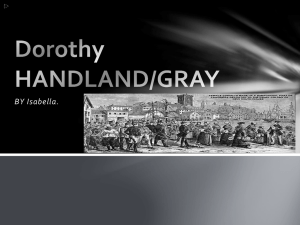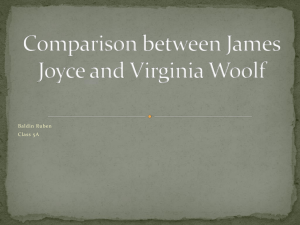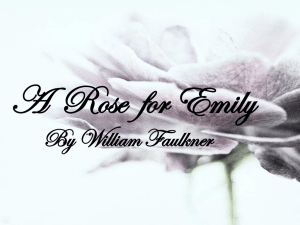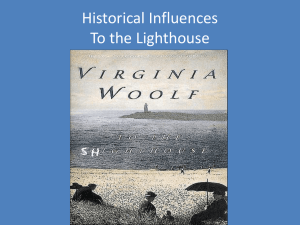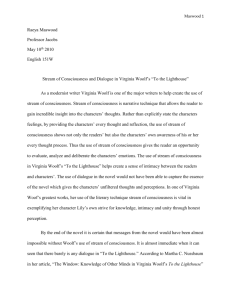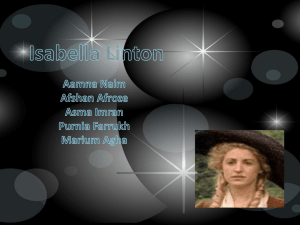Virginia Woolf
advertisement
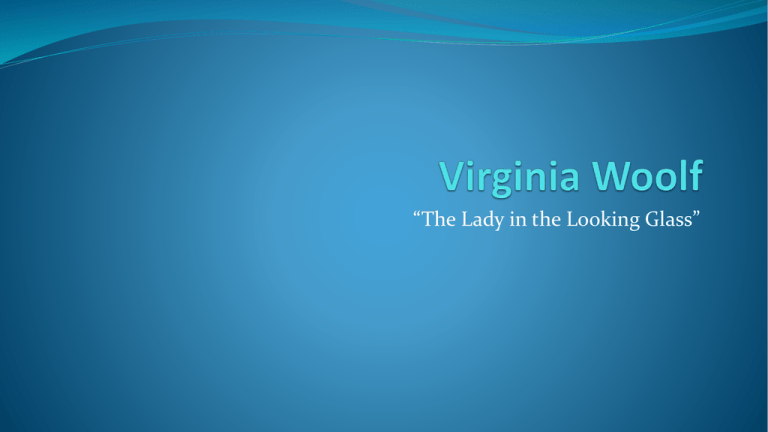
“The Lady in the Looking Glass” Stream of consciousness Woolf considered a leading modernist. “Examine for a moment an ordinary mind on an ordinary day. The mind receives a myriad impressions—trivial, fantastic, evanescent, or engraved with the sharpness of steel. . . . Let us record the atoms as they fall upon the mind in the order in which they fall, let us trace the pattern, however disconnected and incoherent in appearance, which each sight or incident scores upon the consciousness,” - Virginia Woolf in “Modern Fiction” . Stream of consciousness As a literary term, stream of consciousness appears in the early twentieth century. Primarily associated with the modernist movement. Fractured narrative and chronology. Stream of consciousness is a method of narrative representation of "random" thoughts which follow in a freely-flowing style. Fragments of random, disconnected thoughts. Sensory impression occurs as simple lists of a character’s sensations or impressions. The Lady in the Looking Glass “People should not leave looking-glasses hanging in their rooms any more than they should leave open cheque books or letters confessing some hideous crime.” The story uses a looking glass as a metaphor for the lady's character. Describes the images reflected in a mirror situated in a woman’s dressing room, providing a glimpse of the furnishings of her life, but not allowing us a glimpse into the more private aspects of her character. Woolf provides us with all the possessions of the woman, but the woman herself remains absent. The Lady in the Looking Glass The narrator, situated inside the house, watches an elderly lady, Isabella Tyson, working in the garden through a reflection in the mirror. “how little, after all these years, one knew about her.” The sketch continues with a description of the letters that are imagined within the cabinets and drawers of the room, which, along with the furniture itself, seem to possess more knowledge of Isabella than the narrator. When the mail is delivered, the letters are imagined as “tablets graven with eternal truth; if one could read them, one would know everything there was to be known about Isabella, yes, and about life, too”. The issue of selfhood, and the possibility of its narrative articulation. Questions whether or not the self can ever be formulated ‘accurately’ within the limited terms of language. The looking-glass motif functions as a surface upon which the self might be reflected. Woolf questions whether the self is unitary, constant and finally knowable, or fragmented and unstable. Woolf explores the extent to which the private self can be conceptualized as a fixed, unitary, and bounded identity. Tension between the individual’s public personae and his or her ‘private’ self. ‘it was strange that after all these years one could not say what the truth about Isabella was’. The ultimate unknowability of the self is an important theme for Woolf. Question of the identity of the lady in the looking glass. Theme of the split self. Contrast between the interior of the house and its exterior as seen through the looking glass. The interior is a world of movement. It is portrayed as a dynamic environment that is constantly in a state of flux from one state to another. A person's character is something which changes according to mood or circumstance. It cannot be captured in one still image. It is in constant motion. The external image of the house in the looking glass reflection is that part of the self as seen by the world. Established facts about Isabella's life: that she is single, rich and travels, as if these things embody the lady herself and tell the reader everything he needs to know. But what is hiding deep within Isabella's mind? As Isabella makes her way back to the house and finds her letters, the narrator feels that she sees the true woman. And in her the narrator finds nothing. This beautiful woman with the lovely house and exciting life is nothing but empty. As Isabella makes her way back to the house and finds her letters, the narrator feels that she sees the true woman. And in her the narrator finds nothing. This beautiful woman with the lovely house and exciting life is nothing but empty. “that seemed like some acid to bite off the unessential and superficial and to leave only the truth (…) Here was woman herself. (…) Isabella was perfectly empty. She had no thoughts. She had no friends. She cared for nobody. As for her letters, they were all bills. Look, as she stood there, old and angular, veined and lined…” Portrait of a woman whose character is examined both from outside and in, and found to be empty. ‘The Lady in the Looking-Glass’ thus exemplifies the modernist principles Woolf outlines in her essay ‘Modern Fiction’ (1921), in which she advocates the presentation of ‘this varying, this unknown and uncircumscribed spirit’ of personal consciousness, rather than ‘the alien and external’, the dry events of a life.
